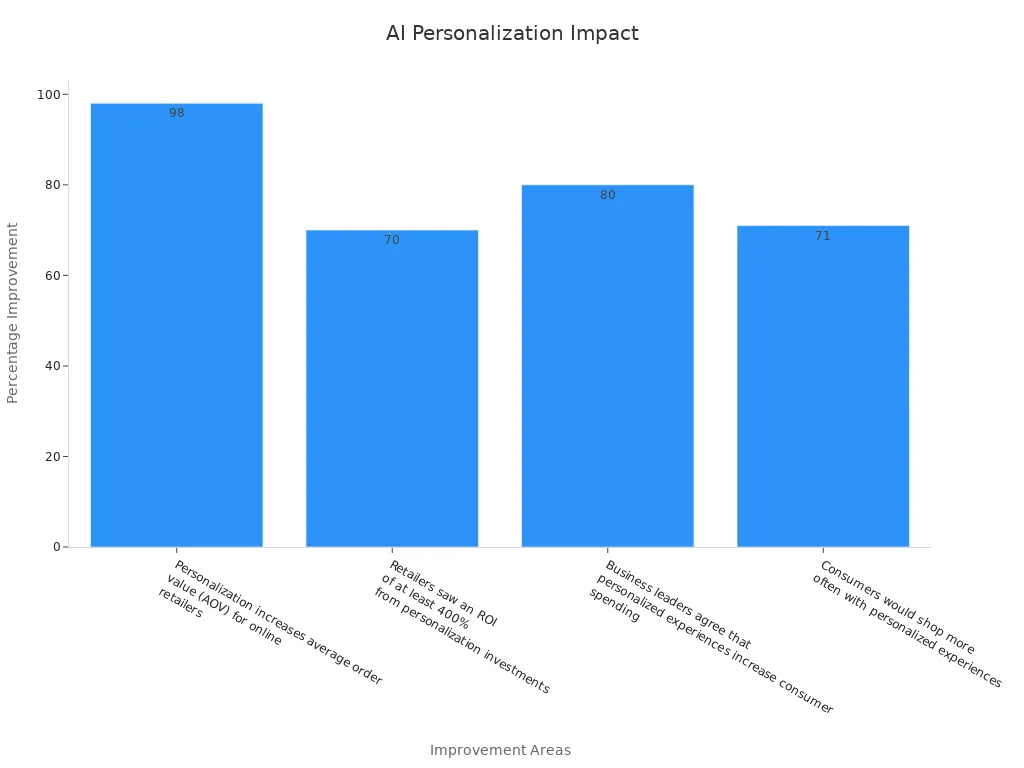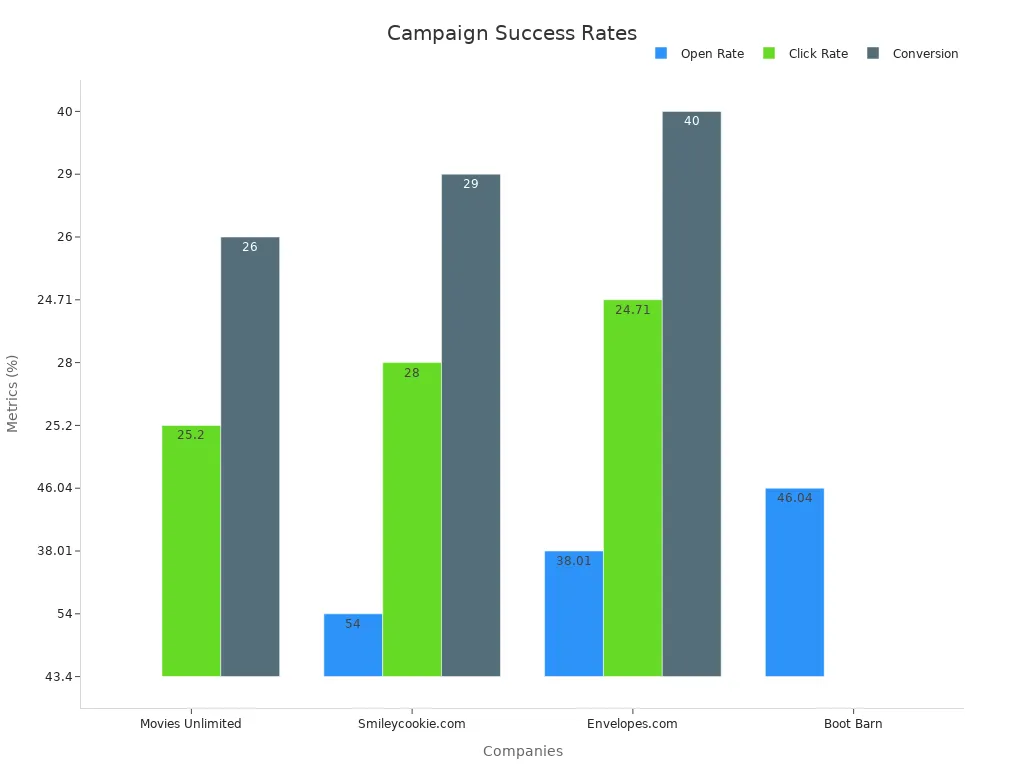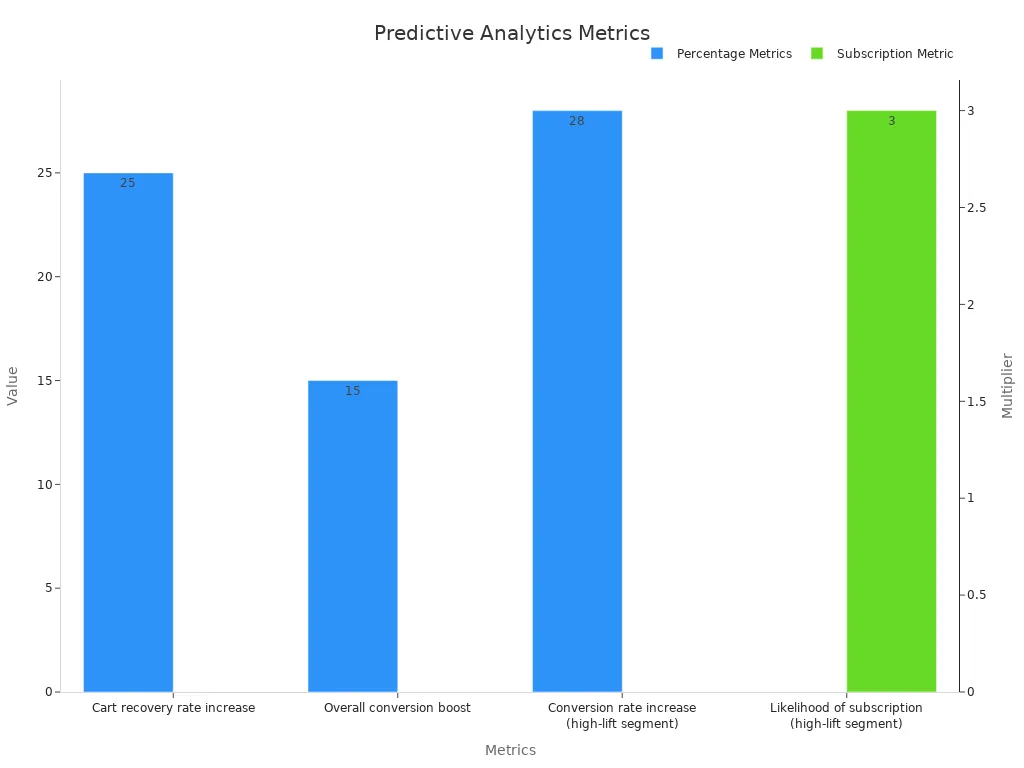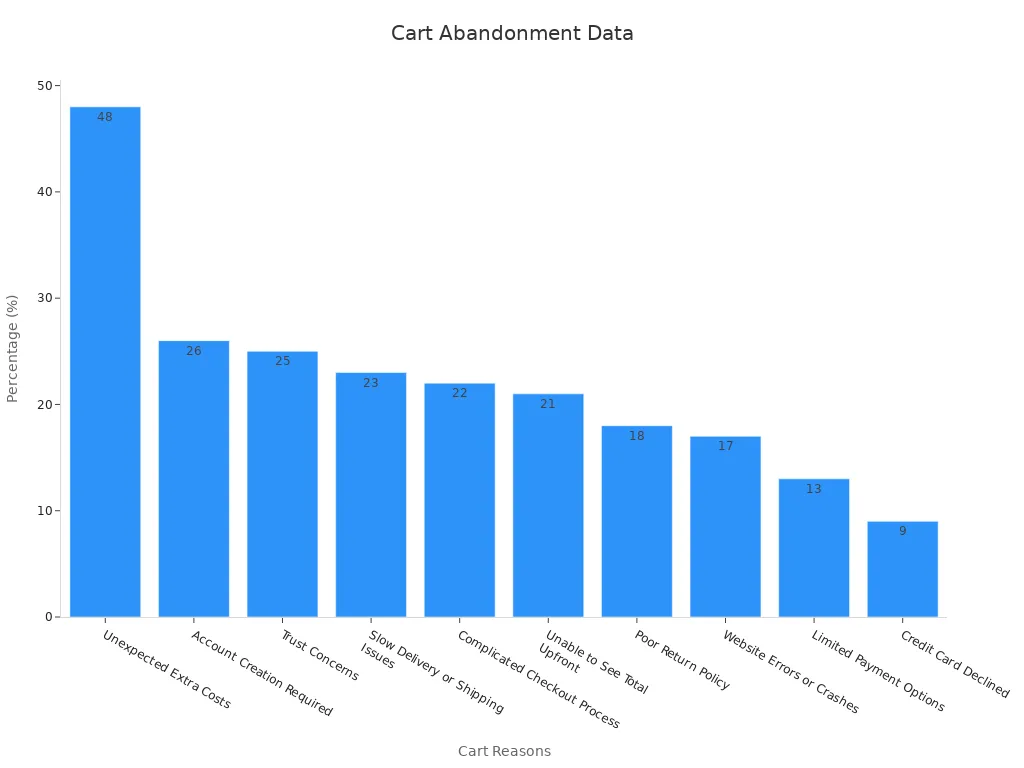The Role of AI in Reducing Cart Abandonment

Shopping online can be annoying when people leave items behind. Did you know almost 70 out of 100 carts are left? That means only 30 shoppers finish buying their items. This is where the role of AI becomes helpful. AI uses smart tools to study how customers act, making shopping feel personal and easier to finish. These tools help lower cart abandonment and boost store success.
Key Takeaways
AI makes shopping personal, helping customers find and buy what they like.
Hidden costs at checkout cause most cart abandonment; show prices clearly.
A simple checkout process lowers cart abandonment; use fewer steps and clear directions.
Giving many payment choices makes customers happy and lowers cart abandonment.
AI tools like chatbots and predictions can bring back lost sales and build trust.
Common Reasons for Cart Abandonment
Unexpected Costs at Checkout
Have you ever added items to your cart and seen surprise fees? It’s annoying, right? Many shoppers stop buying when extra costs like taxes or shipping appear. These hidden charges are the number one reason people leave their carts.
Source | Percentage of Cart Abandonment Due to Unexpected Costs |
|---|---|
Databox | |
The Good | 49% of serious shoppers leave because of surprise costs. |
Shopify | 47% of shoppers abandon carts due to unexpected fees. |
When stores don’t show costs upfront, it feels dishonest. This can make you unsure about finishing your purchase.
Complicated or Lengthy Checkout Process
A confusing checkout process can make people give up. If it’s too long or hard to follow, shoppers often quit. Did you know 17% of shoppers leave their carts for this reason? Too many steps or unclear directions can make buying frustrating.
Here’s a surprising fact: checkout flows in the U.S. have 23.48 form elements on average. That’s a lot of typing! A faster and simpler checkout keeps shoppers interested and ready to buy.
Limited Payment Options
Imagine finding something great but not being able to pay your way. It’s frustrating, isn’t it? Limited payment choices cause many shoppers to leave during checkout.
A high checkout abandonment rate shows payment problems.
A high payment failure rate means stores need more payment options.
Flexible payment methods, like digital wallets or buy-now-pay-later, make buying easier for everyone.
Security and Trust Concerns
Have you ever worried about your payment being unsafe online? You’re not the only one. Many people leave their carts because they don’t trust the website. Missing safety symbols or unclear payment steps can feel risky.
Lots of shoppers quit when they doubt payment safety.
Studies show missing security signs, like padlocks, raise cart abandonment.
"Seeing padlocks or security badges makes customers feel safer buying online." – Mark Angew, CEO of Eyeglasses.com
Stores need to show they care about keeping you safe. Look for websites with SSL certificates, trust badges, or secure payment options. These small things help you feel more confident while shopping.
Browsing Without Purchase Intent
Do you ever add items to your cart just to look? Maybe you’re checking prices or saving items for later. This happens a lot. About 43% of U.S. shoppers say they’ve left carts because they were “just browsing” or not ready to buy.
Many people treat online shopping like window shopping.
Even with a perfect checkout, browsing leads to cart abandonment.
This isn’t always bad. It shows people like what the store offers. Stores can still bring you back. They might send a reminder email or offer a small discount to encourage you to finish your purchase.
The Role of AI in Addressing Cart Abandonment

Personalizing Your Shopping Experience
Have you noticed how some stores seem to know you? That’s AI making shopping feel personal. It studies what you browse, buy, and like. Then, it shows you items you might want. This helps you find things faster and finish buying them.
Personalized shopping isn’t just fun—it works well for businesses too. Stores using AI see big improvements. For example:
Improvement Type | Percentage | Source |
|---|---|---|
AI boosts average order value (AOV) for stores | ||
Stores earn 400% ROI from personalization tools | 70% | |
Personalized shopping makes people spend more | 80% | |
Shoppers return more often with personalization | 71% |
AI also powers features like “Recommended for You” sections. These tools can increase sales by up to 288%. So, when you see suggestions online, that’s AI helping you shop smarter.

Predicting What You’ll Want Next
AI doesn’t just watch what you do—it guesses your next move. Predictive analytics uses data to figure out what you might need. For example, if you look at winter coats, AI might suggest scarves or gloves too.
This helps stores stop cart abandonment. They can send discounts or reminders to encourage you to buy. Predictive analytics also keeps customers coming back. Studies show it can lower customer loss by 20%, especially early on.
Improvement Type | Percentage Reduction |
|---|---|
Customer Loss Reduction | 20% |
Early Loss Reduction | 15% |
Stores don’t guess—they use data to make smart choices. This makes shopping easier and more enjoyable for you.
Chatbots for Instant Help
Ever had a question while shopping but didn’t want to wait? AI chatbots are here to help. They answer questions quickly and guide you through shopping. They can even help with returns or checkout.
Chatbots do more than just talk. They suggest products and solve problems fast. They’re available all day, every day, so you always get help.
Chatbots improve shopping in many ways:
Metric | Description | Measurement Method |
|---|---|---|
Response Time | How fast the chatbot answers your questions. | Time to first response, welcome time, and resolution time. |
Resolution Rate | How many questions the chatbot solves alone. | Ratio of solved questions to total questions. |
Customer Satisfaction (CSAT) | How happy customers are with chatbot help. | Surveys rating chatbot experience from 1 to 5. |
Net Promoter Score (NPS) | How likely customers are to recommend the chatbot. | Survey asking how likely they’d refer it on a 10-point scale. |
Chatbots save businesses money and make shopping easier for you. They’re like having a helper ready whenever you need one.
Dynamic Pricing and Discounts
Have you seen prices change for the same item? That’s dynamic pricing. AI makes this happen by studying lots of data. It looks at demand, competitor prices, and your shopping habits. Then, it adjusts prices instantly to give you the best deal while helping stores earn more.
Dynamic pricing isn’t just good for stores—it helps you too. For example, if you leave items in your cart, AI might offer a discount. This makes you feel special and encourages you to buy. Stores using AI pricing see more sales and fewer abandoned carts.
Here’s how it works:
AI watches how you shop and finds patterns.
It checks competitor prices to stay fair.
It changes prices based on demand, time, or location.
This method benefits everyone. You get discounts, and stores recover lost sales. AI is changing how online shopping works with smart pricing.
Retargeting and Email Campaigns
Have you ever gotten an email about items left in your cart? That’s retargeting, and AI makes it better. AI studies your shopping habits to create emails that catch your attention and bring you back to buy.
AI-powered emails do more than remind you. They include special offers, like discounts or free shipping, to make you want to finish your purchase. These strategies work really well. For example:
Company | Open Rate | Click Rate | Conversion Rate | ROI |
|---|---|---|---|---|
Movies Unlimited | 43.4% | 25.2% | 26% | 500% |
Smileycookie.com | 54% | 28% | 29% | N/A |
Envelopes.com | 38.01% | 24.71% | 40% | 65% |
Boot Barn | 46.04% | N/A | N/A | N/A |
These numbers show how helpful AI is for recovering carts. For example, Smileycookie.com got 29% of carts back with three simple emails. Envelopes.com cut cart abandonment by 40% and boosted sales by 65% with targeted emails.
AI also predicts what you might buy next. Businesses using AI emails see 44% more sales than regular retargeting.

So, when you get a perfectly timed email with a great deal, remember—it’s AI making your shopping easier and more fun.
Real-World Examples of AI Reducing Cart Abandonment

Case Study: AI Personalization Increasing Sales
AI personalization changes how stores connect with shoppers. It adjusts shopping to match what each person likes. This makes people more likely to buy. For example, HulkApps saw a 10x jump in organic traffic after using AI. Serenity, another store, got thousands of clicks and views in two months. These results show how personalization keeps customers interested.
Here’s what they achieved:
Outcome Description | Measurable Result |
|---|---|
Organic Traffic Increase | 10x increase for HulkApps |
Conversion Rate Improvement | 35% increase after personalized campaigns |
Customer Engagement Growth | Thousands of impressions and clicks gained by Serenity |
Other companies also saw big improvements. Adidas and others boosted their sales a lot. Check this out:
Company/Study | Conversion Rate Increase | Source |
|---|---|---|
E-commerce Retailer | 30% | Internal Case Study |
Adidas | 30% | Harvard Business Review, 2022 |
McKinsey Study | 25% | McKinsey, 2021 |
These numbers prove AI personalization helps stores sell more. When shopping feels made for you, it’s easier to buy what you need.
Example: Chatbots Helping Shoppers Finish Buying
AI chatbots are like helpful assistants for online shopping. They answer questions fast and guide you through checkout. Imagine having help anytime you need it. That’s what chatbots do.
Here’s how they help:
Live chat support clears up confusion during checkout.
Shoppers with help are more likely to finish buying.
The results are impressive:
Metric | Result |
|---|---|
Customer Satisfaction (CSAT) | 37% improvement |
Customer Retention | 50% boost |
Customer Acquisition Cost (CAC) | 30% reduction |
Conversion Rate | 12% increase |
Sales Growth | 3X increase |
Chatbots make shopping easier and boost sales. They’re like friendly helpers always ready to assist.
Example: Predictive Analytics Making Retargeting Better
Predictive analytics uses data to guess what you’ll buy next. AI studies your shopping habits and sends offers you’ll like. This brings you back to finish buying.
For example, Adidas used predictive analytics to grow their e-commerce revenue by 26%. L’Oréal cut their customer costs by 35%. These tools make retargeting smarter.
Company | Improvement Type | Percentage Improvement |
|---|---|---|
Adidas | E-commerce revenue increase | 26% |
L’Oréal | Reduction in customer acquisition cost | 35% |
Predictive analytics also helps recover carts and boost sales. Look at these results:
Metric | Value |
|---|---|
Cart recovery rate increase | 25% |
Overall conversion boost | 15% |
Conversion rate increase (high-lift segment) | 28% |
Likelihood of subscription (high-lift segment) | 3x |

AI helps stores send offers that feel personal and timely. This not only saves lost sales but also builds trust with shoppers.
Steps to Use AI for Reducing Cart Abandonment
Find Out What Bothers Customers
To fix cart abandonment, first learn why it happens. Understand what makes shopping hard for your customers. Here’s how to do it:
Check data from your website and tools like CRM. Look for spots where shoppers quit during checkout.
Ask for feedback through surveys, reviews, or social media. People often share what bothers them.
Use empathy maps to see what customers think and feel. This shows hidden problems you might miss.
Tip: Listening to customers is super important. Their feedback can show problems that numbers don’t.
By spotting these issues, you’ll know where AI can help most.
Pick the Best AI Tools
Not all AI tools work the same way. Choose tools that solve your store’s specific problems. For example, if surprise fees are a big issue, AI can offer discounts or better pricing. Here’s a list of common problems and how AI helps:
Problem Shoppers Face | Percentage (%) | AI Solution Example |
|---|---|---|
Surprise Extra Costs | 48 | Smart pricing and special discounts |
Forced Account Creation | 26 | AI guest checkout options |
Worries About Safety | 25 | AI adds trust badges and secure payments |
Slow Shipping | 23 | AI predicts faster delivery times |
Confusing Checkout | 22 | AI makes checkout easier and faster |

Pick tools that match what your customers need. AI chatbots, smart searches, and personalized suggestions can really help.
Add AI to Your Online Store
After picking tools, connect them to your store’s system. This step can be tricky but is very important. Here are some common problems and how to solve them:
Problem/Metric | Solution |
|---|---|
Keeping Data Safe | Protect customer info when using AI. |
Lack of Skilled Workers | Hire or train people who know AI and data. |
Bad Data Quality | Use clean and correct data for better AI results. |
High Setup Costs | Start small and grow as you see success. |
Note: Keeping data safe is a big deal. Over 52% of companies say it’s a major worry with AI. Follow privacy rules to earn customer trust.
Adding AI isn’t just about tech—it’s about making shopping smoother. When done well, AI can boost sales, make customers happy, and improve your store.
Keep an Eye on AI and Make It Better
After adding AI tools, you need to check how they work. Watching and improving their performance helps your store get the best results. But how can you tell if your AI is doing a good job? That’s where tracking important numbers, called performance indicators, helps.
Start by looking at key numbers. These show how well your AI tools are working. For example:
Customer Service Chatbots: See how fast they reply, how well they understand questions, and how happy customers feel after using them.
Fraud Detection Systems: Check how often they catch fraud and avoid mistakes.
You can also use special numbers to learn more about AI performance. Here are some examples:
Mean Squared Error (MSE): Shows how close predictions are to real results.
Perplexity: Measures how well a language model guesses text. Lower scores mean better guesses.
Fréchet Inception Distance (FID): Compares AI-made images to real ones to check quality.
Here’s a table of common AI performance numbers for better understanding:
Indicator | What It Means |
|---|---|
Accuracy | How many predictions or guesses are correct. |
Precision | How many results are useful out of all the results. |
Recall | How many useful results were found out of all possible useful results. |
F1 Score | A balance between precision and recall to measure overall performance. |
Mean Absolute Error (MAE) | The average difference between what AI predicts and the actual result. |
Tip: Check these numbers often to find ways to improve. Even small changes can make a big difference.
Improving AI isn’t something you do just once. It’s something you keep doing. Test, study, and adjust your tools regularly. This keeps your customers happy and helps your store grow.
AI is changing how we shop online. It helps stores fix problems fast and makes shopping easier. AI gives personal suggestions that make 49% of people buy extra items. This helps stores sell more! Also, 64% of store owners think AI makes customers happier. Using AI, stores can get back lost sales, sell more, and earn your trust. AI is super important for keeping up in today’s busy online shopping world.
Want a better shopping experience? AI is already helping you!
FAQ
What is cart abandonment, and why is it important?
Cart abandonment happens when you add items but don’t buy them. This is bad for stores because they lose sales. For you, it might mean missing out on things you liked. AI helps by making shopping simpler and more fun.
How does AI know what I might like to buy?
AI looks at what you’ve searched, bought, or liked before. It uses this information to suggest things you may enjoy. For example, if you check out sneakers, AI might show you socks or gym clothes. It’s like having a helper who knows your taste!
Are AI chatbots safe to use?
Yes, they are! Chatbots don’t keep private details like your credit card info. They’re made to answer questions and help you shop. Look for websites with safety symbols to make sure your data is secure.
Can AI really help stop cart abandonment?
Yes, it can! AI makes shopping personal, gives discounts, and reminds you about your cart. It also makes checkout easier and offers quick help through chatbots. These tools make it simpler to finish buying what you want.
Should I worry about AI using my data?
Not really. Most AI tools follow rules to keep your data safe. They use your info to make shopping better, not to invade your privacy. If you’re unsure, check the website’s privacy policy to see how they handle your data.
See Also
Content Creation Showdown: Writesonic AI Versus QuickCreator
Achieving SEO Excellence: A Detailed Guide Using Perplexity AI
Which SEO Trends Are You Monitoring for 2024?
Enhancing Mobile Responsiveness for Blogs: A Complete Guide
Five Effective Strategies to Boost Healthcare Content Marketing

